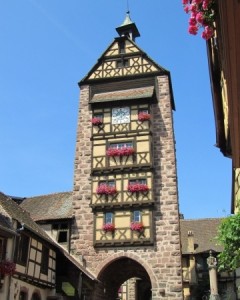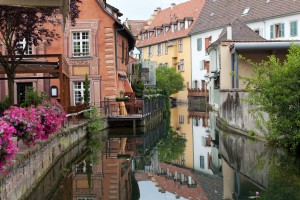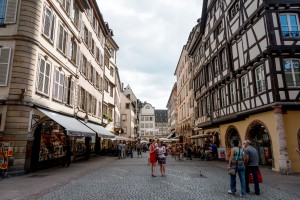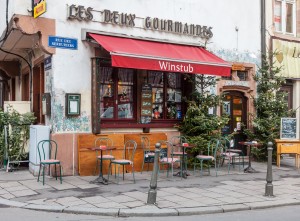Today we have a guest post from Houston-based Wine Educator James Barlow, CS, CWE. James article is all about the glory that is Alsatian wine – and an attempt to understand why more wine professionals and consumers alike don’t seem to truly appreciate this unique wine region.
In my humble opinion, Alsace is, unequivocally, one of the best producers of white wine in the world.
And yet, I have worked in wine retail industry for a decade and have often scratched my head at lack of Alsatian sales. The region seems to play second fiddle to Germany and other white wine producing areas in France.
There’s no argument that Alsatian wines are an enigma – first and foremost for the mere fact that it is the only region in France that puts the varietal on the front label. But somehow, this does not lead the American consumer to gravitate more towards these wines. Sommeliers and retailers alike often note that the wines of Alsace are a niche hand sell. The question is why?
It could be due to the common misperception that Alsace produces wines that are light and sweet; in reality, they are, for the most part, dry and full bodied. It could also be that all of us – consumers and wine professionals alike – just need to take a closer look at Alsace and its long history of vine and wine.
 The region has exchanged hands between France and Germany several times and even had its independence for a brief period. It is separated from the rest of France by the Vosges Mountains in the west. Most vineyards are located in a long thin strand throughout the foothills of the Vosges. This mountain range gives Alsace a unique ‘rain shadow’ effect which makes it one of the driest climates in all of France. Colmar, the capital of the Haut Rhin, is the driest city in France.
The region has exchanged hands between France and Germany several times and even had its independence for a brief period. It is separated from the rest of France by the Vosges Mountains in the west. Most vineyards are located in a long thin strand throughout the foothills of the Vosges. This mountain range gives Alsace a unique ‘rain shadow’ effect which makes it one of the driest climates in all of France. Colmar, the capital of the Haut Rhin, is the driest city in France.
Alsace is divided into two departments, the Haut-Rhin and Bas-Rhin with the former housing over two-thirds of the regions Grand Cru vineyards. There are 51 Grand Crus overall with Kaefferkopf being the latest addition in 2006. The Grand Cru vineyards are typically located on south or southeasterly exposures which give the vines ample sunlight to reach phenolic ripeness. Most Grand Crus require 100% single varietal wines produced from one of the four noble varietals, which include Riesling, Muscat, Pinot Gris, and Gewurztraminer. Grand Cru vineyards have strict requirements as to minimum must weight, alcohol, and hand harvesting.
Alsace is a kaleidoscope of soil structures with ‘gres de Vosges’ pink sandstone being the most famous. The higher elevation villages are generally composed of schist, granite and volcanic sediment, whereas the lower villages typically are more clay over limestone based. The plains consist of richer more alluvial clay and gravel soils.
White varietals are 90% of the production of wine in Alsace, which in turn are dominated by the four noble grapes. These wines are markedly different than those of neighboring Germany. Alsatian wines are typically fermented dry, whereas the Germans have a classically sweeter appeal. The dry wines of Alsace can be some of the most food friendly wine in the world, especially with spicy cuisine. They have higher alcohol while retaining excellent acidity which makes them some of the longest lived white wines in the world.
 Alsace is the one region on Earth where these four noble white grapes are at their richest and most voluptuous expressions. Alsatian Rieslings are some of the more powerful expressions of the varietal produced. They are amongst the longest lived dry whites in the world with a plethora of acidity and minerality to go with the higher alcohol content. Zind Humbrecht Riesling Brand Grand Cru is a stellar example with Master of Wine Olivier Humbrecht at the helm. He is an ardent believer in biodynamics and the terroir really shows in the wines produced. One might note that the residual sugars have been creeping up in recent years.
Alsace is the one region on Earth where these four noble white grapes are at their richest and most voluptuous expressions. Alsatian Rieslings are some of the more powerful expressions of the varietal produced. They are amongst the longest lived dry whites in the world with a plethora of acidity and minerality to go with the higher alcohol content. Zind Humbrecht Riesling Brand Grand Cru is a stellar example with Master of Wine Olivier Humbrecht at the helm. He is an ardent believer in biodynamics and the terroir really shows in the wines produced. One might note that the residual sugars have been creeping up in recent years.
Pinot Gris (formerly Tokay d’Alsace) thrives in Alsace. In fact, this region may have the most complex expression of the varietal in the world. The Pinot Grigios of Italy are typically light and tart, whereas Pinot Gris in Alsace tends to exude a rich, round mouth feel with just a touch of residual sugar and higher alcohol. Trimbach is one of the better producers. They make a moderately priced Reserve Pinot Gris that is full bodied and power packed full of delicious tropical fruits, crushed rocks, and poignant acids.
Gewurztraminer is a pink skinned variety that shows excellent aromatics and spiciness combined with a round, textured mouth feel and spectacular minerality when grown in Alsace. Gewurz, meaning spice in German, is believed to have been first encountered in the German speaking town of Tramin located in northern Italy, and thus the complicated name. Gewurztraminer is usually sweeter than Riesling and offers perfumed bouquets of white flowers and rich tropical fruits. Domaine Weinbach’s Gewurztraminer Altenbourg Cuvee Laurence offers one of the best versions of this dynamic variety.
Muscat is more distinguished here than its counterparts throughout France. Alsatian Muscat offers grapey, floral notes that can be appreciated in a young wine, but can also produce some age-worthy dessert wines. Selection de Grains Nobles is a wine produced from botrytised grapes. This only occurs in perfect weather conditions, so the wines are quite rare. These wines are fully sweet and can be aged indefinitely. They are considered some of the best dessert wines in the world. Marcel Deiss is a stunning producer of not only Muscat but all the noble varietals in the Selection de Grains Nobles style.
I believe the average consumer’s misunderstanding of the Alsatian wines keeps them from delving fully into its wines. The stigma that is haunting Alsace must be changed. It must be up to the wine professionals who are in love with these exquisite wines to slowly but surely teach the modern, wine-savvy consumer to fall in love with Alsace – the unheralded king of white wines.
Our guest author, James Barlow, CS, CWE, is a wine director of over 6,000 wines labels for a store owned by Spec’s Fine Wines and Liquors in Houston, Texas. He is also the author of the widely recognized wine blog thewineepicure.com. James is also a recent recipient of the CWE Certification (Congratulations, James!) and as such has taken on the duty of teaching the Certified Specialist of Wine course to fellow employees in hopes of having the best educated staff in the state of Texas. Way to go, James!
Click here to return to the SWE Website.

